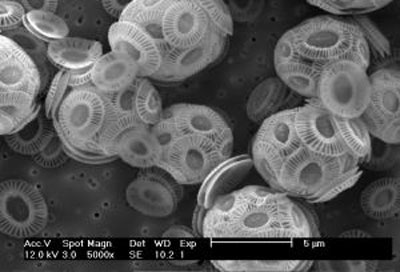| Mar 18, 2015 |
Haptophytes as a model of cell-free biomineralization
|
|
(Nanowerk News) Biogenic calcite produced by microalgae differs from fossil calcite mainly by its extraordinary three-dimensional structure. This unique highly complex shape of the calcite disks, called coccoliths, results from controlled crystal growth in the center of the alga. Scientists of Karlsruhe Institute of Technology (KIT) study the fundamentals of this biomineralization. Potential fields of application of biogenic calcite particles are novel products in optics, paints, and surface coatings.
|
 |
| Electron microscopies reveal the extraordinary three-dimensional structure of the calcite particles formed by microalga Emiliania huxleyi. (Image: Frank Friedrich, KIT)
|
|
The scanning electron microscope reveals the filigree three-dimensional calcium and bicarbonate structures formed by the alga Emiliania huxleyi. Ioanna Hariskos, doctoral student of the KIT Institute of Process Engineering in Life Sciences, Bioprocess Engineering Division, compares the extraordinary structure of the calcite disks with flat, fine sink strainers that are connected by a central tunnel.
|
|
“These complicated irregular structures of coccoliths can only be produced by nature. They can be obtained neither by grinding limestone nor by the precipitation of lime milk.” Hariskos says.
|
|
At KIT, the bioengineer is involved in the interdisciplinary cooperation project “Cell-free biomineralization with calcium carbonate being used as an example: A way towards in-vitro synthesis of highly structured composite materials (ZeBiCa²)”. The project is aimed at reproducing coccolith formation by bioengineering methods using calcareous algae as a model, but without organisms.
|
|
The project focuses on potential industrial applications: The microstructure of the surface and special chemical and physical properties of the calcite particles have a considerable potential for use in innovative products. “Chemical composition of coccoliths may probably be influenced, which might be used to specifically adjust the resulting mechanical properties,” the scientist points out. It might be feasible to use calcite particles as novel coloring agents. Coccoliths might provide paper with special color or glazing properties or used in abrasive paper.
|
|
According to Hariskos, birefringence of calcite – the property of splitting light into two beams – might be applied in optics. “When we will understand the fundamentals of the bioprocess forming the coccoliths, we may succeed in producing further materials, structures, and properties,” the bioengineer explains.
|
|
Together with a small team of students, Hariskos developed a cultivation method to produce large amounts of coccoliths. She grows Emiliania huxleyi, a monocellular phytoplankton, in the bioreactor with modified artificial seawater. In nature, 1000 up to a maximum of 100,000 cells of the microscopically small calcite former are found in 1 ml seawater.
|
|
“At the laboratory, we succeeded in cultivating 50 to 100 million cells per milliliter, which is a sensationally high yield,” Hariskos says. “We offer the algae a much better environment than the sea,” the bioengineer emphasizes.
|
|
Apart from controlled nutrient supply, light plays an important role. “In the bioreactor, the algae performing photosynthesis are provided with light for 24 hours a day and light intensity can be adapted to the respective culture density,” Hariskos says. A KIT-developed enclosure of light-emitting diodes is applied.
|

